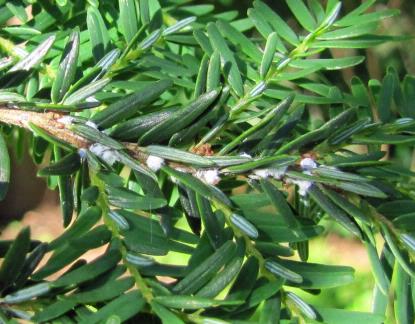In many temperate biological communities trees are the dominant organisms in terms of biomass. That is to say, trees are really big and around here most land should be covered by
trees. Trees are also producers. Unlike animals, the so-called 47%, trees produce their own sugar using the energy of the sun and the ever increasing amounts of carbon dioxide we provide them with..
Here in Massachusetts one of our great tree species is the Tsuga canadensis, the Eastern hemlock (canadensis is Latin for “eastern,” Tsuga of course means “not a pine tree”). Old hemlocks make beautiful silent forest cathedrals if left to their own devices.
Sadly, we have introduced them to a sucky little bug, the wooly adelgid. Adelgids, like Hondas, originally hailed from Japan but are now regularly made in the US. The adelgids are also not unionized, but unlike Honda they are “true bugs” meaning they are in the hemipteran order of insects like aphids and stink bugs.
Adelgids crawl around sucking the delightfully sweet and amino acid rich sap of the hemlock, then secrete a white fibrous mess to protect their eggs: that later part earns them the “wooly” monicker.
As I mentioned, adelgids are not native to the continent so they have no predators. Our hemlock forests are like the all-you-can eat $5 buffet at Cici’s pizza. Once you start eating, only a coronary can stop you. For the adelgid substitute cold winters for coronaries.

Adelgids have two generations a year — one hatches in early summer and begins eating. In the hottest months of the year it goes dormant then wakes up again in October to eat and mature through the winter. If temperatures stay in the low 20’s for much of the winter, they won’t make it to spring. These days that happens less and less, so the adelgid invasion marches northward. The adults that survive the winter lay eggs which hatch in spring as a mixture of winged and unwinged adelgids.
Just as optimistic twenty-somethings flock to nasty dance clubs, the winged adelgids fly off to find Japanese spruce trees so that they can have sexy times. They fail and die as the Japanese spruce trees aren’t here.
For many twenty-somethings the prospects are a bit better. This is also true for the unwinged adults. these just lay more eggs without the sexy times. All the adelgid egg laying that goes on in this country happens without males because of the lack of the right kind of spruce trees. Pointy heads call this “parthenogenesis.” In Greek this means to build the parthenon and has very limited utility. In biologese it means when females reproduce clonally. Luckily human type women haven’t figured out how to do this or there’d be no reason to even have dance clubs.
Just as with mosquitoes, female adelgids do all the damage, and the damage is quite severe, we’re losing our hemlocks and this means losing a cornerstone of our forests. Such an enormous organism that has survived for decades or in some case centuries can be brought down through the concerted action of insects we don’t even see, that live less than a year, and they’re not even unionized.


